Wenjie Luo
Efficient Multi-Camera Tokenization with Triplanes for End-to-End Driving
Jun 13, 2025Abstract:Autoregressive Transformers are increasingly being deployed as end-to-end robot and autonomous vehicle (AV) policy architectures, owing to their scalability and potential to leverage internet-scale pretraining for generalization. Accordingly, tokenizing sensor data efficiently is paramount to ensuring the real-time feasibility of such architectures on embedded hardware. To this end, we present an efficient triplane-based multi-camera tokenization strategy that leverages recent advances in 3D neural reconstruction and rendering to produce sensor tokens that are agnostic to the number of input cameras and their resolution, while explicitly accounting for their geometry around an AV. Experiments on a large-scale AV dataset and state-of-the-art neural simulator demonstrate that our approach yields significant savings over current image patch-based tokenization strategies, producing up to 72% fewer tokens, resulting in up to 50% faster policy inference while achieving the same open-loop motion planning accuracy and improved offroad rates in closed-loop driving simulations.
CopyrightMeter: Revisiting Copyright Protection in Text-to-image Models
Nov 20, 2024



Abstract:Text-to-image diffusion models have emerged as powerful tools for generating high-quality images from textual descriptions. However, their increasing popularity has raised significant copyright concerns, as these models can be misused to reproduce copyrighted content without authorization. In response, recent studies have proposed various copyright protection methods, including adversarial perturbation, concept erasure, and watermarking techniques. However, their effectiveness and robustness against advanced attacks remain largely unexplored. Moreover, the lack of unified evaluation frameworks has hindered systematic comparison and fair assessment of different approaches. To bridge this gap, we systematize existing copyright protection methods and attacks, providing a unified taxonomy of their design spaces. We then develop CopyrightMeter, a unified evaluation framework that incorporates 17 state-of-the-art protections and 16 representative attacks. Leveraging CopyrightMeter, we comprehensively evaluate protection methods across multiple dimensions, thereby uncovering how different design choices impact fidelity, efficacy, and resilience under attacks. Our analysis reveals several key findings: (i) most protections (16/17) are not resilient against attacks; (ii) the "best" protection varies depending on the target priority; (iii) more advanced attacks significantly promote the upgrading of protections. These insights provide concrete guidance for developing more robust protection methods, while its unified evaluation protocol establishes a standard benchmark for future copyright protection research in text-to-image generation.
Precipitation Nowcasting Using Diffusion Transformer with Causal Attention
Oct 17, 2024



Abstract:Short-term precipitation forecasting remains challenging due to the difficulty in capturing long-term spatiotemporal dependencies. Current deep learning methods fall short in establishing effective dependencies between conditions and forecast results, while also lacking interpretability. To address this issue, we propose a Precipitation Nowcasting Using Diffusion Transformer with Causal Attention model. Our model leverages Transformer and combines causal attention mechanisms to establish spatiotemporal queries between conditional information (causes) and forecast results (results). This design enables the model to effectively capture long-term dependencies, allowing forecast results to maintain strong causal relationships with input conditions over a wide range of time and space. We explore four variants of spatiotemporal information interactions for DTCA, demonstrating that global spatiotemporal labeling interactions yield the best performance. In addition, we introduce a Channel-To-Batch shift operation to further enhance the model's ability to represent complex rainfall dynamics. We conducted experiments on two datasets. Compared to state-of-the-art U-Net-based methods, our approach improved the CSI (Critical Success Index) for predicting heavy precipitation by approximately 15% and 8% respectively, achieving state-of-the-art performance.
Improving Agent Behaviors with RL Fine-tuning for Autonomous Driving
Sep 26, 2024



Abstract:A major challenge in autonomous vehicle research is modeling agent behaviors, which has critical applications including constructing realistic and reliable simulations for off-board evaluation and forecasting traffic agents motion for onboard planning. While supervised learning has shown success in modeling agents across various domains, these models can suffer from distribution shift when deployed at test-time. In this work, we improve the reliability of agent behaviors by closed-loop fine-tuning of behavior models with reinforcement learning. Our method demonstrates improved overall performance, as well as improved targeted metrics such as collision rate, on the Waymo Open Sim Agents challenge. Additionally, we present a novel policy evaluation benchmark to directly assess the ability of simulated agents to measure the quality of autonomous vehicle planners and demonstrate the effectiveness of our approach on this new benchmark.
Waymax: An Accelerated, Data-Driven Simulator for Large-Scale Autonomous Driving Research
Oct 12, 2023
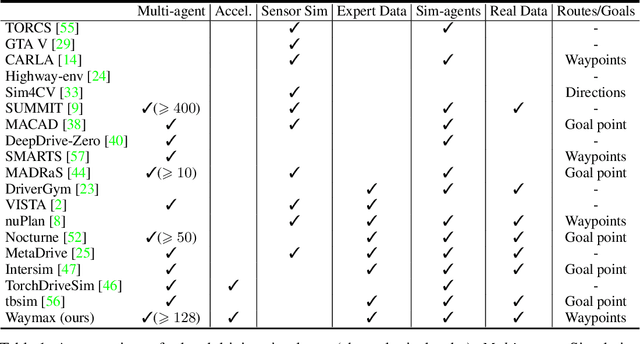


Abstract:Simulation is an essential tool to develop and benchmark autonomous vehicle planning software in a safe and cost-effective manner. However, realistic simulation requires accurate modeling of nuanced and complex multi-agent interactive behaviors. To address these challenges, we introduce Waymax, a new data-driven simulator for autonomous driving in multi-agent scenes, designed for large-scale simulation and testing. Waymax uses publicly-released, real-world driving data (e.g., the Waymo Open Motion Dataset) to initialize or play back a diverse set of multi-agent simulated scenarios. It runs entirely on hardware accelerators such as TPUs/GPUs and supports in-graph simulation for training, making it suitable for modern large-scale, distributed machine learning workflows. To support online training and evaluation, Waymax includes several learned and hard-coded behavior models that allow for realistic interaction within simulation. To supplement Waymax, we benchmark a suite of popular imitation and reinforcement learning algorithms with ablation studies on different design decisions, where we highlight the effectiveness of routes as guidance for planning agents and the ability of RL to overfit against simulated agents.
JFP: Joint Future Prediction with Interactive Multi-Agent Modeling for Autonomous Driving
Dec 16, 2022
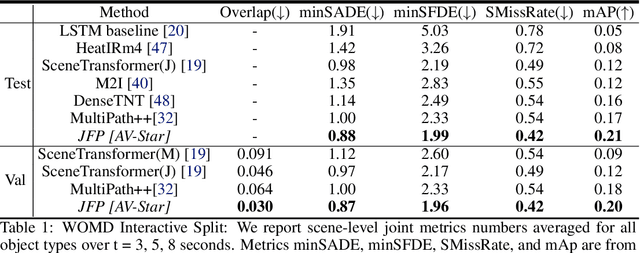

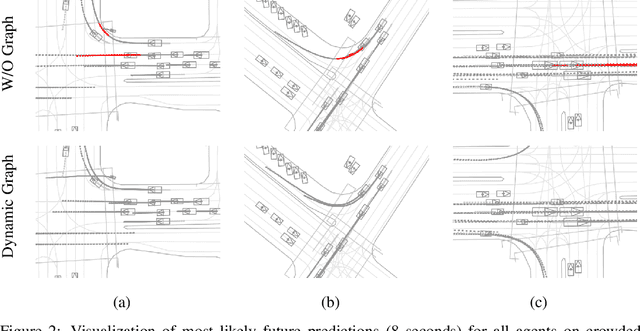
Abstract:We propose JFP, a Joint Future Prediction model that can learn to generate accurate and consistent multi-agent future trajectories. For this task, many different methods have been proposed to capture social interactions in the encoding part of the model, however, considerably less focus has been placed on representing interactions in the decoder and output stages. As a result, the predicted trajectories are not necessarily consistent with each other, and often result in unrealistic trajectory overlaps. In contrast, we propose an end-to-end trainable model that learns directly the interaction between pairs of agents in a structured, graphical model formulation in order to generate consistent future trajectories. It sets new state-of-the-art results on Waymo Open Motion Dataset (WOMD) for the interactive setting. We also investigate a more complex multi-agent setting for both WOMD and a larger internal dataset, where our approach improves significantly on the trajectory overlap metrics while obtaining on-par or better performance on single-agent trajectory metrics.
Indoor Smartphone SLAM with Learned Echoic Location Features
Oct 16, 2022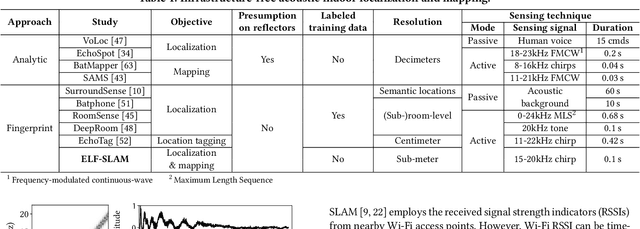
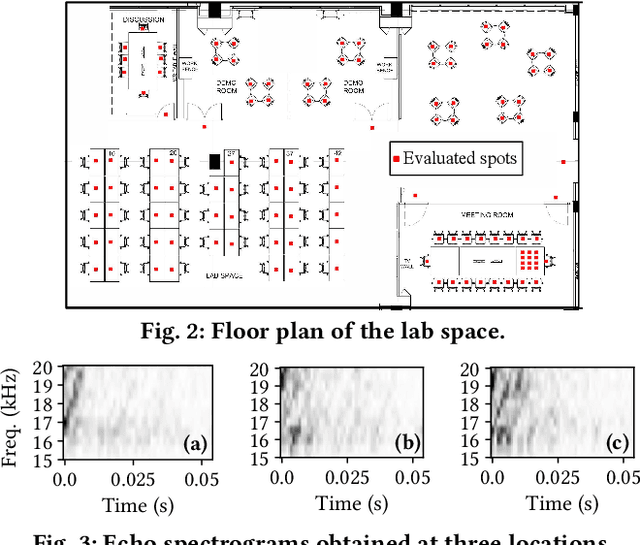

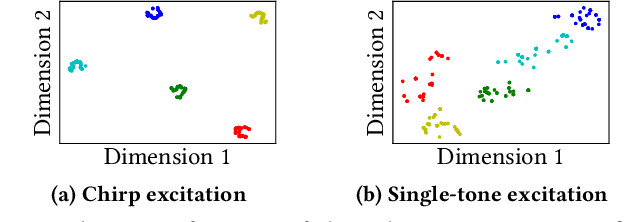
Abstract:Indoor self-localization is a highly demanded system function for smartphones. The current solutions based on inertial, radio frequency, and geomagnetic sensing may have degraded performance when their limiting factors take effect. In this paper, we present a new indoor simultaneous localization and mapping (SLAM) system that utilizes the smartphone's built-in audio hardware and inertial measurement unit (IMU). Our system uses a smartphone's loudspeaker to emit near-inaudible chirps and then the microphone to record the acoustic echoes from the indoor environment. Our profiling measurements show that the echoes carry location information with sub-meter granularity. To enable SLAM, we apply contrastive learning to construct an echoic location feature (ELF) extractor, such that the loop closures on the smartphone's trajectory can be accurately detected from the associated ELF trace. The detection results effectively regulate the IMU-based trajectory reconstruction. Extensive experiments show that our ELF-based SLAM achieves median localization errors of $0.1\,\text{m}$, $0.53\,\text{m}$, and $0.4\,\text{m}$ on the reconstructed trajectories in a living room, an office, and a shopping mall, and outperforms the Wi-Fi and geomagnetic SLAM systems.
Sardino: Ultra-Fast Dynamic Ensemble for Secure Visual Sensing at Mobile Edge
Apr 18, 2022



Abstract:Adversarial example attack endangers the mobile edge systems such as vehicles and drones that adopt deep neural networks for visual sensing. This paper presents {\em Sardino}, an active and dynamic defense approach that renews the inference ensemble at run time to develop security against the adaptive adversary who tries to exfiltrate the ensemble and construct the corresponding effective adversarial examples. By applying consistency check and data fusion on the ensemble's predictions, Sardino can detect and thwart adversarial inputs. Compared with the training-based ensemble renewal, we use HyperNet to achieve {\em one million times} acceleration and per-frame ensemble renewal that presents the highest level of difficulty to the prerequisite exfiltration attacks. Moreover, the robustness of the renewed ensembles against adversarial examples is enhanced with adversarial learning for the HyperNet. We design a run-time planner that maximizes the ensemble size in favor of security while maintaining the processing frame rate. Beyond adversarial examples, Sardino can also address the issue of out-of-distribution inputs effectively. This paper presents extensive evaluation of Sardino's performance in counteracting adversarial examples and applies it to build a real-time car-borne traffic sign recognition system. Live on-road tests show the built system's effectiveness in maintaining frame rate and detecting out-of-distribution inputs due to the false positives of a preceding YOLO-based traffic sign detector.
Joint Forecasting of Panoptic Segmentations with Difference Attention
Apr 14, 2022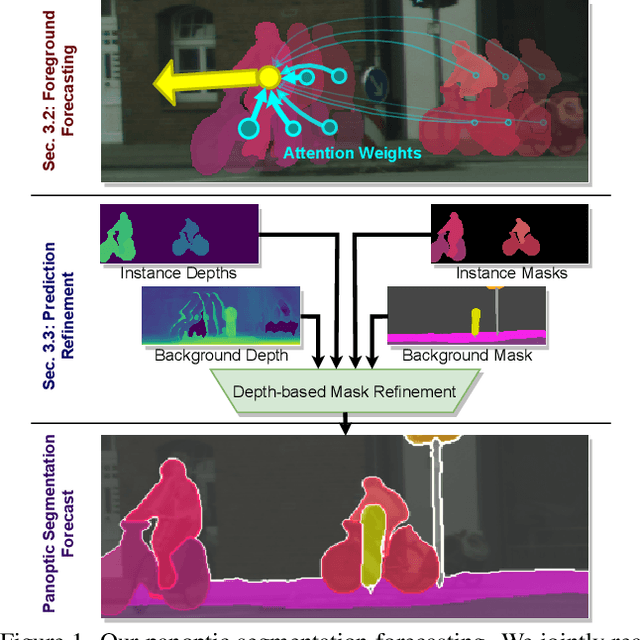


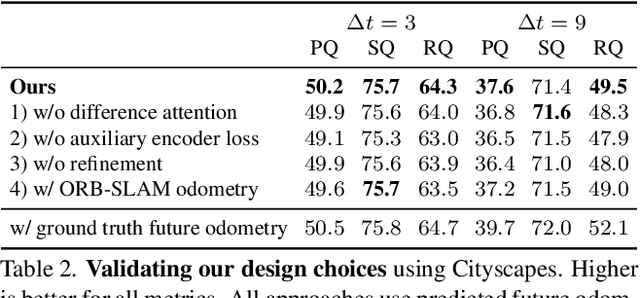
Abstract:Forecasting of a representation is important for safe and effective autonomy. For this, panoptic segmentations have been studied as a compelling representation in recent work. However, recent state-of-the-art on panoptic segmentation forecasting suffers from two issues: first, individual object instances are treated independently of each other; second, individual object instance forecasts are merged in a heuristic manner. To address both issues, we study a new panoptic segmentation forecasting model that jointly forecasts all object instances in a scene using a transformer model based on 'difference attention.' It further refines the predictions by taking depth estimates into account. We evaluate the proposed model on the Cityscapes and AIODrive datasets. We find difference attention to be particularly suitable for forecasting because the difference of quantities like locations enables a model to explicitly reason about velocities and acceleration. Because of this, we attain state-of-the-art on panoptic segmentation forecasting metrics.
PhyAug: Physics-Directed Data Augmentation for Deep Sensing Model Transfer in Cyber-Physical Systems
Apr 19, 2021



Abstract:Run-time domain shifts from training-phase domains are common in sensing systems designed with deep learning. The shifts can be caused by sensor characteristic variations and/or discrepancies between the design-phase model and the actual model of the sensed physical process. To address these issues, existing transfer learning techniques require substantial target-domain data and thus incur high post-deployment overhead. This paper proposes to exploit the first principle governing the domain shift to reduce the demand on target-domain data. Specifically, our proposed approach called PhyAug uses the first principle fitted with few labeled or unlabeled source/target-domain data pairs to transform the existing source-domain training data into augmented data for updating the deep neural networks. In two case studies of keyword spotting and DeepSpeech2-based automatic speech recognition, with 5-second unlabeled data collected from the target microphones, PhyAug recovers the recognition accuracy losses due to microphone characteristic variations by 37% to 72%. In a case study of seismic source localization with TDoA fngerprints, by exploiting the frst principle of signal propagation in uneven media, PhyAug only requires 3% to 8% of labeled TDoA measurements required by the vanilla fingerprinting approach in achieving the same localization accuracy.
 Add to Chrome
Add to Chrome Add to Firefox
Add to Firefox Add to Edge
Add to Edge